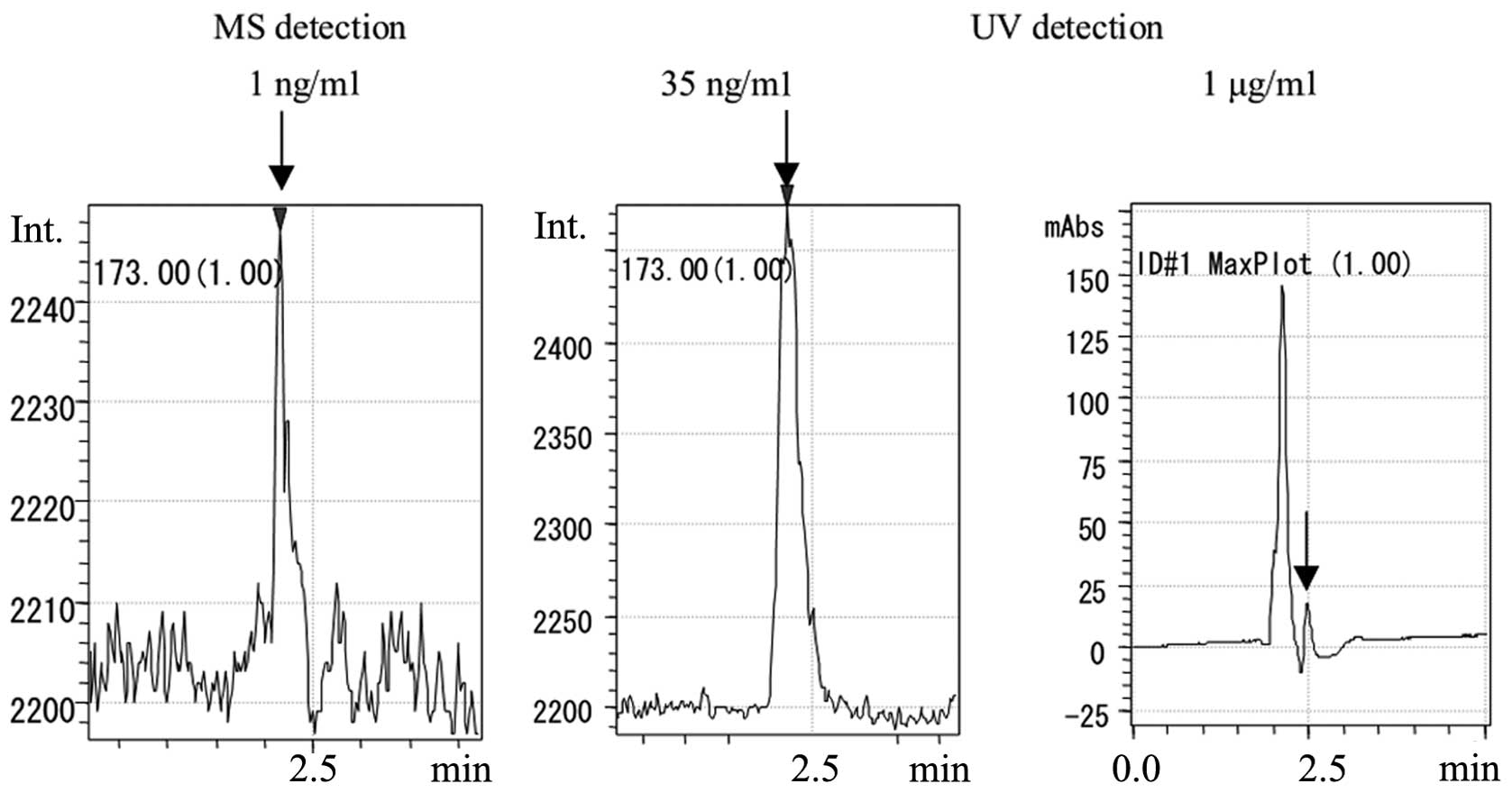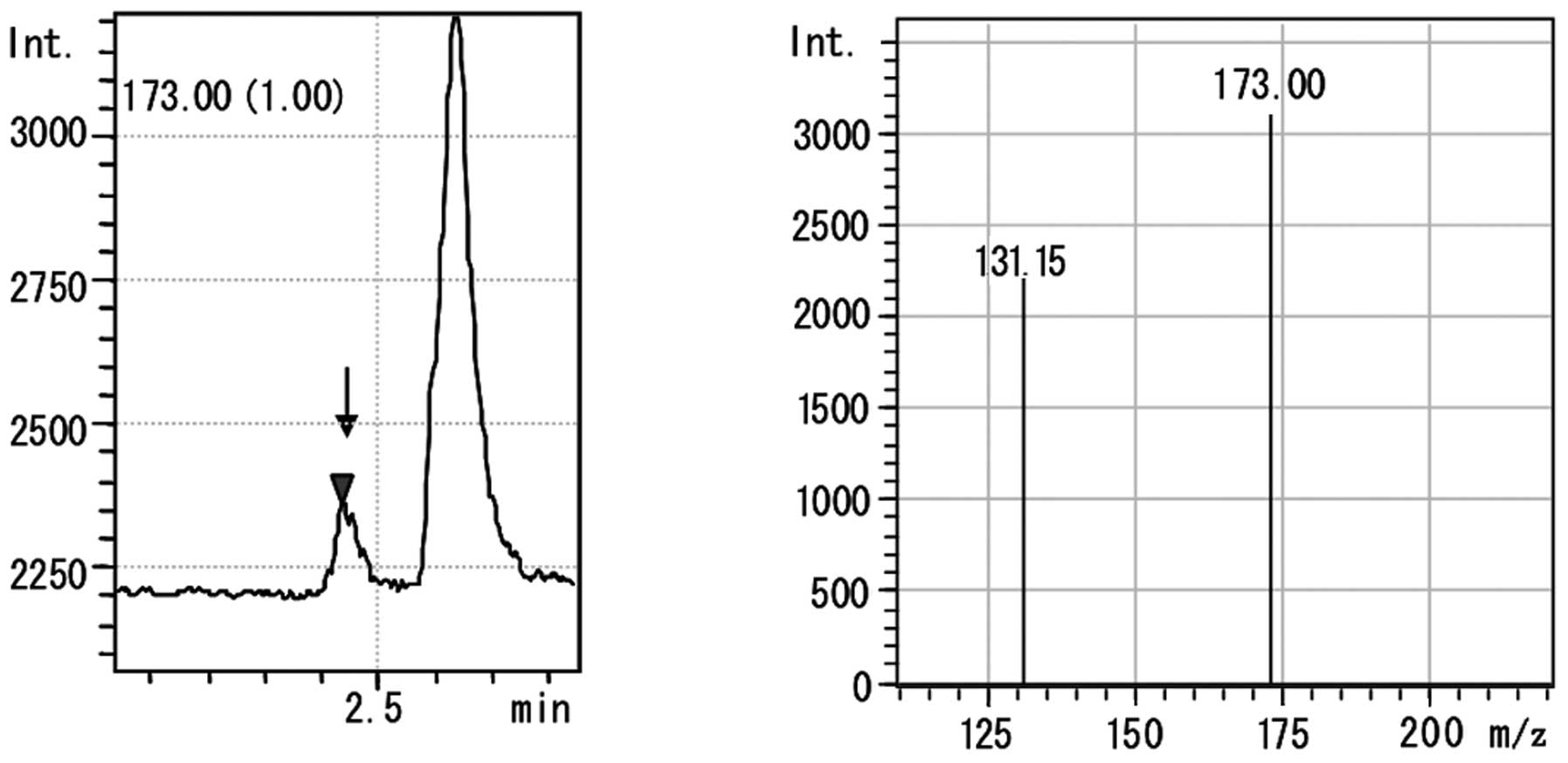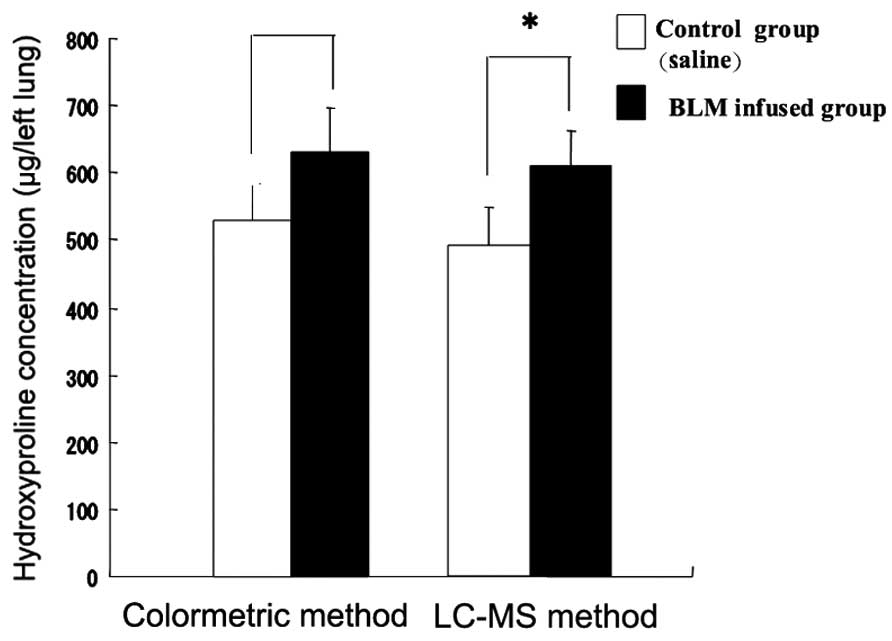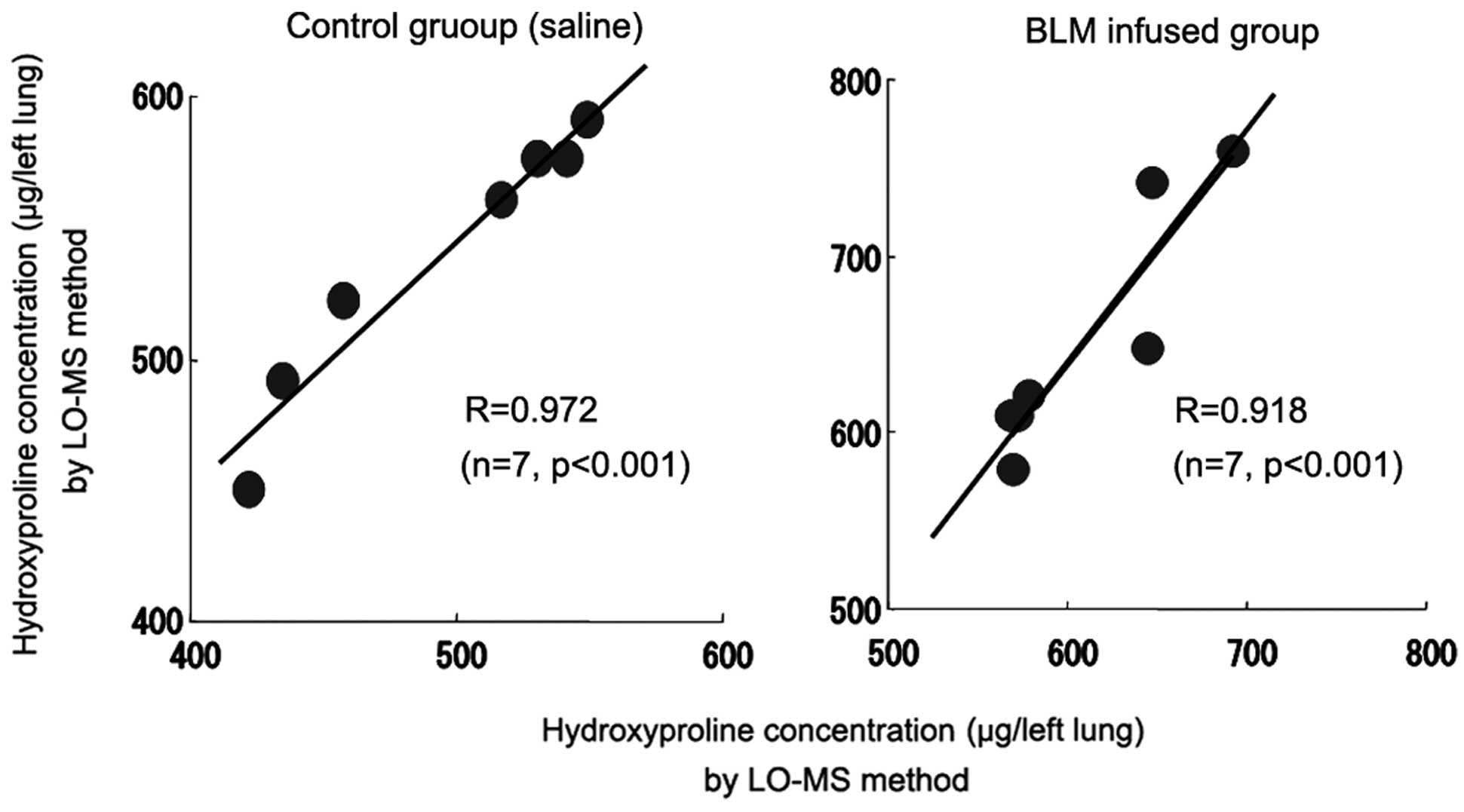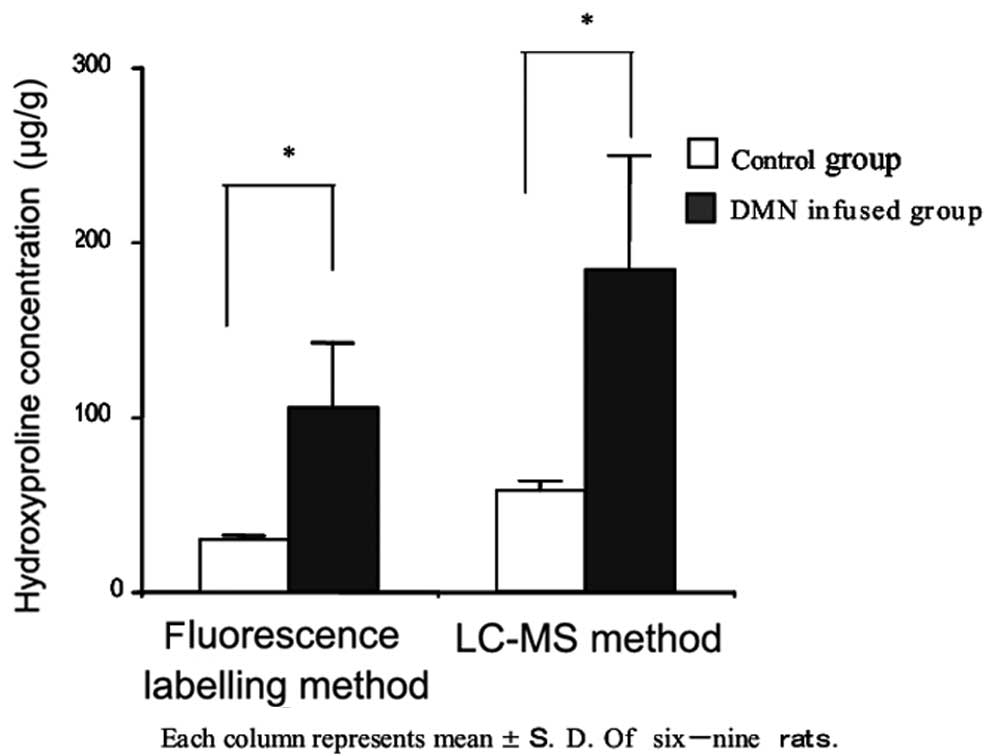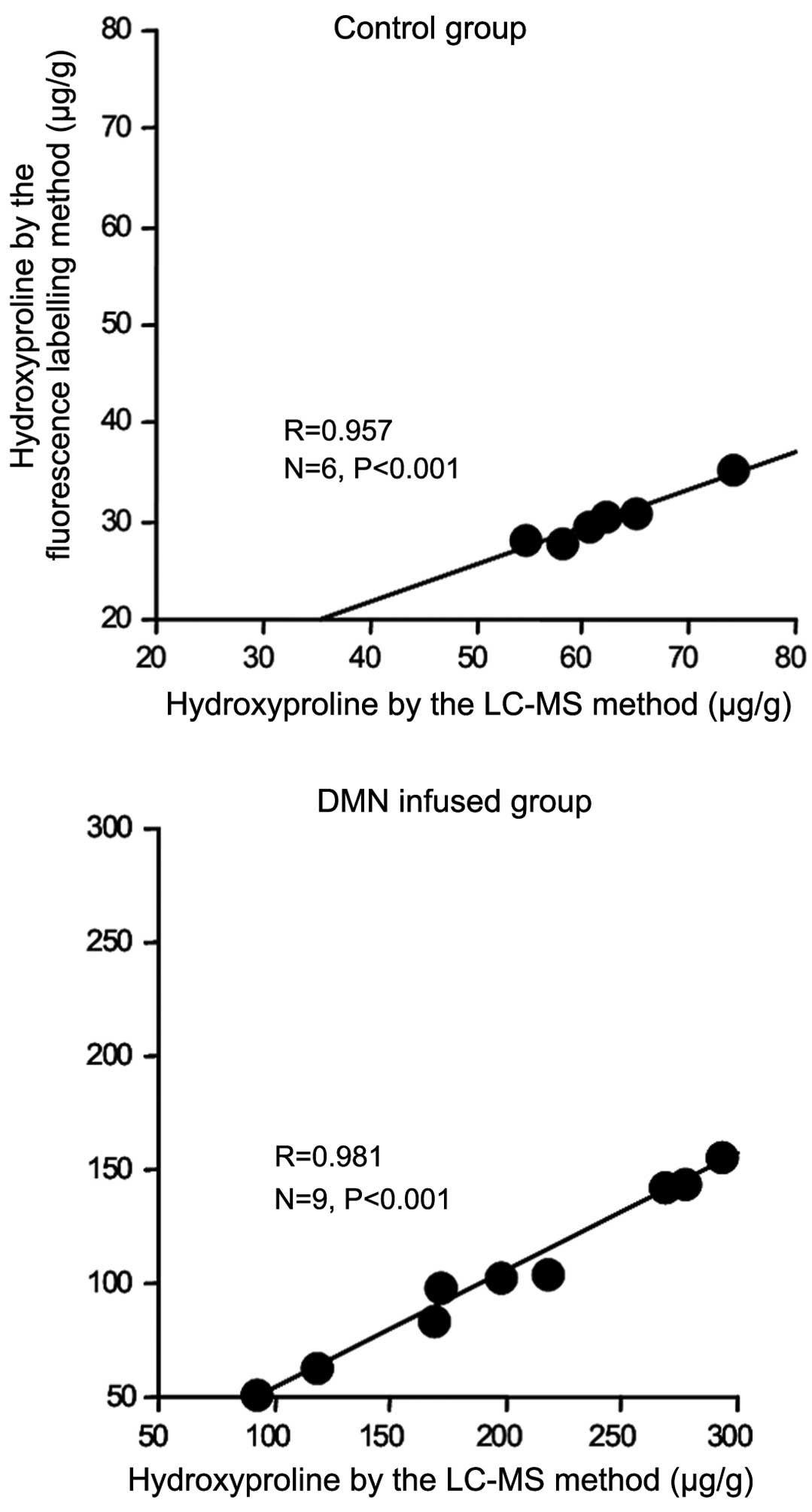Measurement of hydroxyproline in collagen with three different methods
- Authors:
- Published online on: May 23, 2014 https://doi.org/10.3892/mmr.2014.2267
- Pages: 1157-1163
Abstract
Introduction
4-hydroxy-l-proline (hydroxyproline) is a non-proteinogenic amino acid, that has a molecular weight of 131.13 g/mol and is synthesized by post-translational hydroxylation of proline during collagen biosynthesis (Fig. 1). Investigations of physiological and pathological collagen metabolism most commonly utilize measurements of hydroxyproline in the plasma, urine and body tissue. Therefore, determination of hydroxyproline provides useful information for the diagnosis and prognosis of diseases caused by disorders of the collagen metabolism (1). Such conditions include hyperthyroidism, hyperparathyroidism, acromegaly, Paget’s disease, osteomalacia, rickets, Marfan syndrome, osteogenesis imperfecta, sclerodactyly, dermatomyositis and Cushing syndrome (2).
Fibrosis that occurs in the liver, lungs, kidneys, skin and other organs has the capacity to develop into chronic hepatitis, liver sclerosis, liver cancer, pulmonary fibrosis and glomerulonephritis (3). Therefore, preventing the development and reducing the severity of fibrosis in patients is highly important. Hydroxyproline acts as an important diagnostic indicator of the severity of fibrosis.
The measurement of hydroxyproline in plasma, urine and body tissue is possible by colorimetric methods, high-performance liquid chromatography (HPLC) and flow injection analyses (4–6). However, these methods require large sample volumes, due to their low sensitivity. In addition, HPLC requires a long separation time for each sample. In recent years, liquid chromatography-mass spectrometry (LC-MS) has been emerging as advantageous for its high sensitivity and short separation time. LC-MS has been utilized to measure low concentrations of drugs in serum and urine with contaminated substances (7–9). The present study aimed to apply the novel LC-MS method to the measurement of hydroxyproline. As an indicator of fibrosis, hydroxyproline in the liver and lung of a rat model of fibrosis was measured by LC-MS, and compared with previous results obtained by HPLC and colorimetric methods.
Materials and methods
Ethics statement
The study protocol was approved by the Ethics Committee of Harbin Medical University (Harbin, China). A standard procedure for obtaining written informed consent was included in the protocol, and was approved by the Ethics Committee of Harbin Medical University.
Reagents
Dimethylnitrosamine (DMN) and hydroxyproline were obtained from Nacalai Tesque Inc. (Kyoto, Japan). Nembutal was purchased from Dai-Nihon Pharmaceuticals Inc. (Osaka, Japan) and bleomycin was obtained from Nihon Kayaku Inc. (Tokyo, Japan). All other chemicals were of reagent grade.
Preparation of a model of pulmonary and liver fibrosis in rats
A model of pulmonary fibrosis was created in five-week-old Wistar rats by injection of bleomycin (BLM, 0.30 U/100 g, i.p.) in the trachea under nembutal (50 mg/kg) anesthesia. Healthy rats were injected with 0.9% saline (control).
A model of liver fibrosis was created in seven-week-old Wistar rats by a single injection of DMN (40 mg/kg, i.p.). Normal healthy rats were the controls and were injected with 0.9% saline (control). The preparation of the pulmonary liver fibrosis model and of the collection tissue were based on the methods described in the previous studies (10,11).
Measurement of hydroxyproline in a rat model of pulmonary fibrosis by a colorimetric method
The left lung was removed, weighed (~0.3 g) and homogenized in 5% trichloroacetic acid solution (x10 volume) using a cell homogenizer (Eilard, Berlin, Germany) at 8,000 × g (4°C) for 2 min in an ice bath. Cells were centrifuged (2,500 × g, 4°C) for 20 min and the supernatant washed twice with distilled water. Then, 6 N HCl was added at 110°C completely at the beginning and reacted for 16 h. Following completion of the reaction, toluene (3 ml) was added and the mixture was agitated for 20 min. Following centrifugation (3,000 × g, 20°C) for 10 min, the organic layer was collected and p-dimethylaminobenzaldehyde added. Hydroxyproline in the sample was detected using a Multiplate Spectrometer (Ultramark; Bio-Rad, Hercules, CA, USA) at 560 nm.
Measurement of hydroxyproline in the liver by HPLC
The left lung was removed, weighed (~0.3 g) and homogenized in 5 ml ethanol using a cell homogenizer (Eilard) at 8,000 × g (4°C) for 2 min in an ice bath. The homogenate was centrifuged (2,500 × g, 4°C) for 20 min and the supernatant collected. The liquid (1 ml) was obtained and heated for 8 h at 60°C until dry. Following dissolving the residue in 40 μl ethanol and 80 μl borate buffer (0.1 M, pH 8), 40 μl 4-fluoro-7-nitrobenzofurazan (100 mM) was added as a fluorescence reagent. The reaction was allowed to continue at room temperature for 15 h in the dark. Then, 840 μl of hydrochloric acid (6 mol/l) was added to terminate the reaction. Following centrifugation (2,500 × g, 20°C) for 20 min, the supernatant was removed for HPLC analysis.
A Hitachi L6000 HPLC system (Hitachi High Technologies America, Inc., Schaumburg, IL, USA) was used. Detection was performed with a Hitachi L7480 fluorescence spectrometer (Hitachi High-Technologies Corporation, Tokyo, Japan; excitation at 475 nm, emission at 530 nm). The column (Hitachi High-Technologies Corporation) was a YMC Pack ODS-AQ (150×6.0 mm ID) at room temperature. The mobile phase was acetonitrile: water (35:65–50:50 gradient over 15 min) and the flow rate was 1 ml/min.
Measurement of hydroxyproline in pulmonary and liver organization by LC-MS
The left lung was removed, weighed (~0.3 g) and homogenized in 5% trichloroacetic acid solution (x10 volume) using a cell homogenizer (Eilard) at 8,000 × g (4°C) for 2 min in an ice bath. Cells were centrifuged (2,500 × g, 4°C) for 20 min. The supernatant was washed twice with distilled water. Then, 6 N HCl was added at 110°C for 16 h and the samples were prepared for measurement. The liver was removed, weighed (~0.3 g) and homogenized in 5 ml ethanol using a cell homogenizer (Eilard) at 8,000 × g (4°C) for 2 min in an ice bath. The homogenate was centrifuged (2,500 × g, 4°C) for 20 min, the supernatant collected and the samples prepared for measurement.
The concentration of hydroxyproline was determined following an LC-MS method using a LC-MS2020 system (Shimadzu Corp., Kyoto, Japan). With respect to LC, the mobile phase was 5% CH3CN-10 mM CH3COONH4. The column was Shin-pack VP-ODS (150×2 mm diameter). The flow rate was 0.2 ml/min. With regard to MS, atmospheric chemical ionization (APCI) was employed. Positive ion detection was also used. The probe electron voltage was 4.5 kV and the probe current was 4.2 μA. The APCI probe temperature was 250°C and the curved desolvation line (CDL) electron voltage was −30.0 V. The CDL temperature was 250°C and block temperature 20°C. The bias voltage for Q-arrays 1, 2 and 3 were 5.0, 25.0 and 35.0 V, respectively. The Q-array RF electron voltage was 150.0 V.
Statistical analysis
The differences between groups were examined by one-way analysis of variance. If a significant difference was noted, the difference between the groups was examined by the Bonferroni method. Correlations were examined using a two-sided t-test. P<0.05 was considered to indicate a statistically significant difference.
Results
Measurement of the hydroxyproline concentration by LC-MS
MS chromatogram of hydroxyproline
The mass spectrum of hydroxyproline is shown in Fig. 2. MS of the hydroxyproline standard (80 pg/ml) resulted in fragment peaks with a molecular mass of 173.0 (molecular ion + acetic acid-water) generated from addition to acetic acid ammonium for increasing the number of ionic molecules (molecular quantity, 131.15) and ionic strength.
LC-MS chromatogram of hydroxyproline
The LC conditions were as follows: Mobile phase, 5% CH3CN-10 mM CH3COONH4; column, Shin-pack VP-ODS (150×2 mm diameter); flow rate, 0.2 ml/min and ultraviolet (UV) detection at 230 nm. MS was performed using the APCI ionization method and the ion detection was positive.
The LC-MS-selected ion monitoring (SIM) chromatogram of hydroxyproline (m/z, 173.0) is presented in Fig 3. As observed for the hydroxyproline standard, a peak was observed at 1 ng/ml at a retention time of 2.213 min. A sharp peak was also observed at 50 ng/ml. At 1 μg/ml, which was 1,000× the standard concentration, a small peak was noted in the LC-UV spectrum (230 nm).
Sensitivity of LC-MS detection to hydroxyproline
The LC-MS-SIM standard curve of hydroxyproline (m/z, 173.0; molecular ion + acetic acid-water) is shown in Fig. 4. Using the peak area method for the standard curve, hydroxyproline exhibited a sharp peak at 35 ng/ml (Fig. 3). However, at concentrations <35 ng/ml, a correlation among the peak areas was not observed. From 35–560 ng/ml, a correlation among the peak areas was observed and the standard curve was a straight line. At 60 and 80 μg/ml, the peak areas were almost identical. A correlation among the peak areas was not observed at concentrations >60 μg/ml.
LC-MS chromatogram and MS spectrum of hydroxyproline in a model of pulmonary and liver fibrosis in rats
Fig. 5 shows the LC-MS chromatogram and MS spectrum with SIM detection of hydroxyproline (m/z 173.0; molecular ion + acetic acid-water) in a pulmonary model of fibrosis in rats. In the LC-MS chromatogram of the lung, similar to that of the hydroxyproline standard, a distinct peak at m/z 173.0 was observed at a retention time of 2,213 min. Hydroxyproline was identified at m/z 131.15 in the mass spectrum.
Fig. 6 illustrates the LC-MS chromatogram and MS spectrum with SIM detection of hydroxyproline (m/z 173.0; molecular ion + acetic acid-water) in the fibrotic liver tissue of rats. As observed for the hydroxyproline standard, a peak was noted at a retention time of 2.213 min in the LC-MS chromatogram and MS spectrum.
Hydroxyproline concentration in lung tissue (colorimetric and LC-MS methods)
Colorimetric and LC-MS methods employed for the determination of the hydroxyproline concentration in rat lung tissue are compared in Fig. 7. Each column represents the mean ± standard deviation of nine experiments. According to the colorimetric method, the hydroxyproline concentration in rat lung tissue in the BLM-infused group (652.3±70.0 μg/left lung) was significantly higher compared with that in the control group (547.1±52.3 μg/left lung; P<0.05). According to the LC-MS method, the BLM-infused group (610.9±50.3 μg/left lung) had a significantly higher value compared with the control group (493.3±53.5 μg/left lung; P<0.05). However, the hydroxyproline concentration in rat lung tissue measured by the LC-MS method had a lower value compared with that measured by the colorimetric method.
The hydroxyproline concentrations in rat lung tissue measured by colorimetric and LC-MS methods are compared in Fig. 8. A correlation between the colorimetric and LC-MS methods for the determination of the hydroxyproline concentration in the lung tissue of the control group was identified (r=0.972). Similarly, a correlation between the colorimetric and LC-MS methods for the determination of the hydroxyproline concentration in the lung tissue of the BLM-infused group was identified (r=0.918).
Hydroxyproline concentration in rat liver tissue by fluorescence labeling and LC-MS methods
The assessment of the hydroxyproline concentration in rat liver tissue by fluorescence labeling and LC-MS methods is illustrated in Fig. 9. According to the fluorescence labeling method, the hydroxyproline concentration in rat liver tissue of the DMN-infused group (105.4±36.5 μg/g) was significantly higher compared with that in the control group (30.3±2.7 μg/g; P<0.05). Also according to LC-MS analysis, the DMN-infused group (190.4±70.3 μg/g) demonstrated a significantly higher value compared with the control group (62.4±6.8 μg/g; P<0.05). However, the hydroxyproline concentration in rat liver tissue measured by LC-MS was higher compared with that measured by the fluorescence labeling method.
The hydroxyproline concentration in rat liver tissue assessed by fluorescence labeling and LC-MS methods are correlated in Fig. 10. The hydroxyproline concentration in the liver tissue of the control group assessed using fluorescence labeling correlated with that obtained using the LC-MS method (r=0.957). Also, the hydroxyproline concentration in the liver tissue of the DMN-infused group obtained by the fluorescence labeling method correlated with that obtained using the LC-MS method (r=0.981).
Discussion
Hydroxyproline is a type of amino acid found in albumen. The proline residue in the protein is hydroxylated by 4-monooxgenase to generate 4-hydroxy-2-oxoglutal acid, which is converted to alanine and glycine via 4-glutamic acid in the human body. In each internal organ of the body, inflammation and fibrosis may give rise to the accumulation of components of the extracellular matrix (ECM) (12). However, under pathological conditions, additional fibrosis may occur in the liver, lungs and kidneys (13,14). Chronic hepatitis and liver sclerosis are associated with fibrosis and also have a close correlation with liver cancer (15).
In the lungs, the severity of fibrosis is dependent on the type of pneumonia (16). Usually, pulmonary fibrosis accompanies interstitial pneumonia (17). Fibrosis in internal organs is caused by proliferation of ECM components deposited by myofibroblasts. Understanding the development of fibrosis involves the examination of collagen concentration. The hydroxyproline concentration is associated with collagen as an indicator of the severity of fibrosis (18–20). Hydroxyproline is important as an index of the disease caused by collagen proliferation (as in fibrosis) and metabolism malfunction.
In recent years, LC-MS has been demonstrated to be a highly sensitive detection method (7,8,21). LC-MS comprises an LC and MS component, and the interface that connects them. The LC part is identical to conventional HPLC. The sample is ionized by the interface section. Thermospray ionization produced unstable (volatile) products, so that APCI was used (which ionizes material, but not the solvent, following nebulization with solvent under atmospheric pressure). Electrospray ionization (ESI) may be used to ionize molecules of high polarity and high molecular weight, which is ideally suited to the interface component. However, in the present study, ESI was not adapted to the measurement of hydroxyproline in body specimens, as ESI was not accompanied by the thermospray in case of ionization. It was a more simple procedure to measure hydroxyproline combined with Na+ by adding additional Na+ to the sample.
The MS spectrum of hydroxyproline demonstrated peaks of m/z 173.0 and 131.15. m/z 173.0 was identified as the peak representing the acetic-acid salt originating from the acetic acid ammonium that was added to the mobile phase to increase ionic strength. Furthermore, due to the comparative strength of m/z 131.15 and 173.0 being approximately identical in the MS spectrum, the ion of m/z 173.0 was chosen by SIM in the MS chromatogram in order to avoid the interference peak of the mobile phase.
In the MS chromatogram of the hydroxyproline standard at 1 ng/ml, a peak was observed in the SIM measurement with m/z 173.0. In the UV spectrum (230 nm) of hydroxyproline at 1 μg/ml, which was 1,000× the standard concentration, a small peak was observed (measurement was performed at the same time as the LC measurement).
At concentrations <35 ng/ml, among the peak areas, no strong correlation was observed between the different methods, and it was not possible to create a standard curve. It was hypothesized that the analyte may have been affected by the peak of the mobile phase, as hydroxyproline has a comparatively low molecular weight (131.15). In addition, the peak retention time may have become unstable due to the polarity of the solvent at low concentrations (hydroxyproline concentration <35 ng/ml).
It was hypothesized that it may be possible to measure concentrations of substances as low as the pg/ml level. For the peak of hydroxyproline in the MS chromatogram, the retention time was short (2.213 min). The capability of hydroxyproline to be maintained on the ODS column was weaker than originally proposed. The relative ion strength in the MS spectrum at m/z 131.15 and 173.0 was approximately identical, and accordingly, the interference peak of the mobile phase chose an ion of m/z 173.0. In the LC-MS chromatogram of hydroxyproline in lung and liver tissue, a sharp peak of m/z 173.0 was observed at a retention time of 2.213 min, just as for the hydroxyproline standard. With respect to the MS spectrum, the molecular ion peak of hydroxyproline (m/z 131.15) was confirmed.
Measurement of the hydroxyproline concentration in lung and liver tissues by LC-MS was compared with that obtained by the colorimetric method as well as a fluorescence method using HPLC from a previous study by our group. A highly significant positive correlation was noted. However, the value of the hydroxyproline concentration in the lung obtained by the colorimetric method was higher than that obtained by LC-MS. Furthermore, the hydroxyproline concentration in the liver obtained by the fluorescence method using HPLC was lower compared with the value obtained by LC-MS (which was supposed to be a high absorbance of all components in the sample at a constant wavelength of 560 nm).
In conclusion, hydroxyproline, as an indicator of fibrosis, was measured by colorimetric and HPLC methods in previous studies by our group. By comparison, the present study identified that the LC-MS method was more advantageous, characterized by its simple process, high sensitivity (pg level) and short separation time. Further investigations with larger sample sizes are warranted to confirm these results.
Acknowledgements
The authors are grateful to M. Kusunose, M. Ono and A. Hamada (Department of Pharmacy, Kochi Medical School, Kochi, Japan) for providing several reagents used in this study, helpful suggestions and technical expertise. This work was funded by the Public Health Department of Heilongjiang Province (no. 2013365) of China.
References
|
Kitchener RL and Grunden AM: Prolidase function in proline metabolism and its medical and biotechnological applications. J Appl Microbiol. 113:233–247. 2012. View Article : Google Scholar : PubMed/NCBI | |
|
Myllyharju J: Prolyl 4-hydroxylases, key enzymes in the synthesis of collagens and regulation of the response to hypoxia, and their roles as treatment targets. Ann Med. 40:402–417. 2008. View Article : Google Scholar : PubMed/NCBI | |
|
Wick G, Grundtman C, Mayerl C, et al: The immunology of fibrosis. Annu Rev Immunol. 31:107–135. 2013. View Article : Google Scholar | |
|
Hofman K, Hall B, Cleaver H and Marshall S: High-throughput quantification of hydroxyproline for determination of collagen. Anal Biochem. 417:289–291. 2011. View Article : Google Scholar : PubMed/NCBI | |
|
McAnulty RJ: Methods for measuring hydroxyproline and estimating in vivo rates of collagen synthesis and degradation. Methods Mol Med. 117:189–207. 2005.PubMed/NCBI | |
|
McCooeye M and Mester Z: Comparison of flow injection analysis electrospray mass spectrometry and tandem mass spectrometry and electrospray high-field asymmetric waveform ion mobility mass spectrometry and tandem mass spectrometry for the determination of underivatized amino acids. Rapid Commun Mass Spectrom. 20:1801–1808. 2006. View Article : Google Scholar | |
|
Jemal M and Xia YQ: LC-MS Development strategies for quantitative bioanalysis. Curr Drug Metab. 7:491–502. 2006. View Article : Google Scholar : PubMed/NCBI | |
|
Chen G and Pramanik BN: LC-MS for protein characterization: current capabilities and future trends. Expert Rev Proteomics. 5:435–444. 2008. View Article : Google Scholar : PubMed/NCBI | |
|
Becker S, Kortz L, Helmschrodt C, et al: LC-MS-based metabolomics in the clinical laboratory. J Chromatogr B Analyt Technol Biomed Life Sci. 883–884:68–75. 2012. | |
|
Cui T, Kusunose M, Hamada A, et al: Relationship between the eosinophilia of bronchoalveolar lavage fluid (BALF) and the severity of pulmonary fibrosis induced by bleomycin in rats. Biol Pharm Bull. 26:959–963. 2003. View Article : Google Scholar | |
|
Kusunose M, Qiu B, Cui T, Hamada A, et al: Effect of Sho-saiko-to extract on hepatic inflammation and fibrosis in dimethylnitrosamine induced liver injury rats. Biol Pharm Bull. 25:1417–1421. 2002. View Article : Google Scholar : PubMed/NCBI | |
|
Maruyama K: Hydroxproline. Nihon Rinsho. 62(Suppl 12): 220–223. 2004.(In Japanese). | |
|
Muiznieks LD and Keeley FW: Molecular assembly and mechanical properties of the extracellular matrix: A fibrous protein perspective. Biochim Biophys Acta. 1832:866–875. 2013. View Article : Google Scholar : PubMed/NCBI | |
|
Lu P, Takai K, Weaver VM and Werb Z: Extracellular matrix degradation and remodeling in development and disease. Cold Spring Harb Perspect Biol. 3:a0050582011.PubMed/NCBI | |
|
Pungpapong S, Kim WR and Poterucha JJ: Natural history of hepatitis B virus infection: an update for clinicians. Mayo Clin Proc. 82:967–975. 2007. View Article : Google Scholar : PubMed/NCBI | |
|
Strieter RM and Mehrad B: New mechanisms of pulmonary fibrosis. Chest. 136:1364–1370. 2009. View Article : Google Scholar : PubMed/NCBI | |
|
Swigris JJ and Brown KK: Acute interstitial pneumonia and acute exacerbations of idiopathic pulmonary fibrosis. Semin Respir Crit Care Med. 27:659–267. 2006. View Article : Google Scholar : PubMed/NCBI | |
|
Ono M, Miyamura M, Kyotani S, et al: Effects of Sho-saiko-to extract on liver fibrosis in relation to the changes in hydroxyproline and retinoid levels of the liver in rats. J Pharm Pharmacol. 51:1079–1084. 1999. View Article : Google Scholar | |
|
Ono M, Miyamura M, Kyotani S, et al: Effect of Sho-saiko-to extract on HGF and TGF-beta levels of intraorgans in liver-injured rats after partial hepatectomy. J Pharm Pharmacol. 52:111–118. 2000. View Article : Google Scholar : PubMed/NCBI | |
|
Kusunose M, Qiu B, Cui T, et al: Effect of Sho-saiko-to extract on hepatic inflammation and fibrosis in dimethylnitrosamine induced liver injury rats. Biol Pharm Bull. 25:1417–1421. 2002. View Article : Google Scholar : PubMed/NCBI | |
|
Holčapek M, Jirásko R and Lísa M: Recent developments in liquid chromatography-mass spectrometry and related techniques. J Chromatogr A. 1259:3–15. 2012. |





